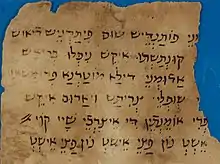Judeo-Latin
Judeo-Latin (also spelled Judaeo-Latin) is the use by Jews of the Hebrew alphabet to write Latin.[2] The term was coined by Cecil Roth to describe a small corpus of texts from the Middle Ages.[2] In the Middle Ages, there was no Judeo-Latin in the sense of "an ethnodialect used by Jews on a regular basis to communicate among themselves", and the existence of such a Jewish language under the Roman Empire is pure conjecture.[3]

The Judeo-Latin corpus consists of an Anglo-Jewish charter and Latin quotations in otherwise Hebrew works (such as anti-Christian polemics, incantations and prayers).[2] Christian converts to Judaism sometimes brought with them an extensive knowledge of the Vulgate translation of the Bible. The Sefer Nizzahon Yashan and Joseph ben Nathan Official's Sefer Yosef ha-Mekanne contain extensive quotations from the Vulgate in Hebrew letters.[2] Latin technical terms sometimes appear in Hebrew texts.[2] There is evidence of the oral use of Latin formulas in dowsing, ordeals and ceremonies.[2]
Leo Levi found some Hebraisms in a few epigraphs in Italy.[4] Other possible sources are loanwords in other languages, like in Sardinian cenabura [ken'abura] 'Friday' (from Latin cena pura) and caputanni, 'September', a literal translation of Rosh Hashanah.
References
- Gideon Bohak, "Catching a Thief: The Jewish Trials of a Christian Ordeal", Jewish Studies Quarterly 13.4 (2006): 344–362.
- Ivan G. Marcus, "Judeo-Latin", in Joseph R. Strayer (ed.), Dictionary of the Middle Ages, Vol. 7 (New York: Charles Scribner's Sons, 1986), pp. 176–177.
- Gad Freudenthal, "Latin-into-Hebrew in the Making: Bilingual Documents in Facing Columns and Their Possible Function", pp. 59–67 in Resianne Fontaine and Gad Freudenthal (eds.), Latin-into-Hebrew: Texts and Studies, Volume One: Studies (Leiden: Brill, 2013), p. 61 and n., who quotes an earlier version of this Wikipedia article to characterize the conjecture: "a presumed Jewish language for many scattered Jewish communities of the former Roman Empire, but especially by the Jewish communities of the Italian Peninsula and Transalpine Gaul."
- Leo Levi, "Ricerca di epigrafia ebraica nell'Italia meridionale," La Rassegna mensile di Israel, vol. 28 (1962), pp. 152-153
Further reading
- Paul Wexler, Three Heirs to a Judeo-Latin Legacy: Judeo-Ibero-Romance, Yiddish and Rotwelsch (Wiesbaden: Otto Harrassowitz, 1988).
External links
- Taylor-Schechter K 1.115, a Judeo-Latin magical text